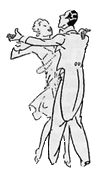 |
ROUND DANCING — CHOREOGRAPHED BALLROOMEDUCATIONAL ARTICLESMAJOR SECTIONS: Figures | Articles | Links | Alph. Index | Search | Home |
|
|
An Alemana Is Not A Twirlby Harold & Meredith Sears Round dancing has many different moods. Different rhythms, and even different figures within a rhythm, can be playful, romantic, haughty, or demanding. One figure might be quite simple and open, while another is complex and rich in emotional depth—and the Alemana Turn is an emotional figure. There is promise and rejection, pursuit and reconciliation. If we dance it like an Underarm Turn, we lose some of that, and if we do a Twirl, we’re singing an entirely different song. The Twirl might begin in semi-closed position. In Two Step, the man steps forward on his left foot and raises lead hands so she can go under, he closes right to left, and then he steps forward left again, lowering the raised hands. The woman steps forward right and turns to the right under raised hands. She steps side and back left, again down line, and completes a full turn, and then she steps side right to face. Notice that the man is doing a Forward Two Step down line, and the woman is doing a Roll Three under joined lead hands. The essential character of this figure is loose and playful. He is sort of skipping down the sidewalk, and she is twirling beside him.The Underarm Turn is a Latin figure. In Rumba, we start in a facing position with the trail feet free. Maybe we’ve just done a Half Basic. Then the man steps back right, raising lead hands, and she crosses her left foot in front of her right, turning 1/2 to the right. On beat two, the man recovers left, and the woman recovers right, completing the turn to face her partner. On the slow count, both step side on the trail feet. This is a quieter figure. We do not have the progression that we had in the Twirl. Second, the steps are not really together. If we begin facing the wall, his first step is backing toward center, and hers is crossing toward line. We’re kind of wandering away from each other. But there is no “wandering” in an Alemana Turn—every step is focused on our partner. The Alemana is a two-measure figure, so the preparatory, Half-Basic–like measure doesn’t need to be cued. We might begin in closed or butterfly position, facing the wall with lead feet free. The man steps forward left (woman back right), recovers, and then closes left to right raising lead hands and turning his upper body a little to the left. The woman takes her lead from this arm and body action, and her third step is forward right, toward his left side, toeing out. Although she is turning 1/8 to the right, here, she might orient her upper body a little left, toward him, and gaze meaningfully into his eyes. In the second measure, the actual Alemana Turn, he steps back right, crossing behind, and he draws her to him. She steps forward left, toward diagonal line and center, and abruptly turns 1/2 to the right. If he is careful to shift lead hands directly over her head, she will be able to swivel in place and on balance. Notice that she does not cross in front and so step away from him. She steps toward him, teasingly, and then turns. During step five, the man recovers left, and the woman steps forward right, now toward diagonal reverse and wall. She is walking away, but he is pursuing. Again, he is careful to keep lead hands over her head, and at the very end of five, she turns sharply 3/8 to the right to face him again. On step six, he closes right to left and she steps side and forward left to closed position. If you would like to think a little in terms of phase-V actions, the woman’s first sharp turn is spiral-like, and her second turn is hip-twist–like. And this is high drama. During steps three and four, boy meets girl. At the end of four and during the beginning of five, boy loses girl. At the end of five and into step six, boy gets girl again. If you dance the Alemana Turn like an Underarm Turn or like a Twirl, you’re dancing a whole different story.
This article was published in the Washington Area Square Dancers Cooperative Association (WASCA) Calls 'n' Cues, May 2008; reprinted in North Carolina Round Dance Association Quarterly Newsletter, November 2013; CRDA Round Notes, March/April 2015; and DRDC Newsletter, May 2021.
If you would like to read other articles on dance position, technique, styling, and specific dance rhythms, you may visit the article TOC. If you are not a member of DRDC, do consider joining. The group sponsors triquarterly weekends with great dancing and teaching, and the newsletter is one of the most informative available. Past DRDC Educational Articles archived here. |
 |
|
|
Page last revised